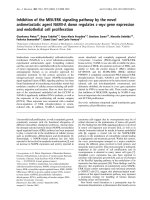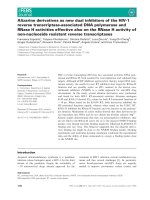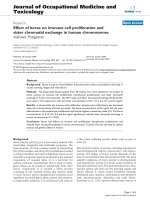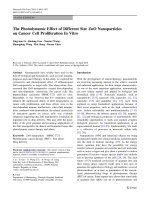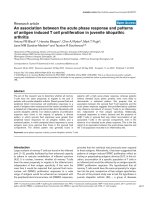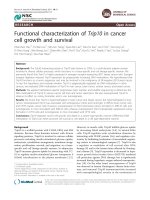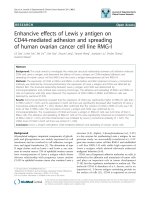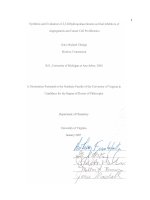synthesis and evaluation of 2,3-dihydroquinazolinones as dual inhibitors of angiogenesis and cancer cell proliferation
Bạn đang xem bản rút gọn của tài liệu. Xem và tải ngay bản đầy đủ của tài liệu tại đây (2.03 MB, 226 trang )
I
UMI Number: 3235027
3235027
2006
Copyright 2007 by
Chinigo, Gary Michael
UMI Microform
Copyright
All rights reserved. This microform edition is protected against
unauthorized copying under Title 17, United States Code.
ProQuest Information and Learning Company
300 North Zeeb Road
P.O. Box 1346
Ann Arbor, MI 48106-1346
All rights reserved.
by ProQuest Information and Learning Company.
II
© Copyright by
Gary Michael Chinigo
All Rights Reserved
January 2007
III
Abstract
Dual inhibitors of cancer cell proliferation and angiogenesis have recently shown
remarkable potential for the clinical treatment of several cancers. Inspired by this success, we
have employed traditional medicinal chemistry techniques to develop a 2,3-dihydroquinazolin-4-
one lead molecule with promising anti-proliferative and anti-angiogenic activity. These
molecules, which we originally derived from thalidomide, have evolved into an extremely
effective (sub-nanomolar) prospective drug candidate for the treatment of cancer.
Described herein is an account of the many structural modifications made to this lead
compound along with the corresponding effects on competitive
3
H colchicine displacement from
tubulin, microtubule depolymerization, and cytotoxicity toward several human cancer and
endothelial cell lines. From these evaluations we were able to design 3
rd
generation analogs with
significantly enhanced potency. Subsequent animal testing suggests these molecules are
relatively non-toxic, bio-available, and efficacious at treating tumors in vivo – evidence which
supports the possibility of our most active analogs being evaluated clinically.
In addition to the SAR studies, we were compelled to develop synthetic methods enabling
us to synthesize the enantiomers of these molecules. Exploration of several different approaches
eventually led us to a chiral auxiliary based method of synthesis. Preliminary success led to a
more thorough exploration of the scope and limitations of this methodology, and ultimately to the
synthesis of the R and S enantiomers of both the lead and our most active molecule. Related X-
ray crystal structure and biological studies conclusively point to the S isomer as the biologically
active enantiomer. Finally, by using molecular modeling in conjunction with all the data gathered
thus far, we have developed a hypothesis regarding the likely mode of interaction between tubulin
and the molecules in this study.
IV
Table of Contents
Copyright II
Abstract III
Table of Contents IV
List of Figures, Tables, & Schemes VII
List of Abbreviations XII
Chapter 1: Introduction 1
1.1 Cancer 2
1.2 Tubulin 4
1.3 Angiogenesis 7
1.4 Discovery of Dihydroquinazolinone SC-2-71 13
1.5 Biological Mechanism of Action 18
1.6 Experimental Design 23
1.7 Chapter 1 References 25
Chapter 2: A-Ring Analogs and B-Ring Analogs 35
2.1 Synthesis of A-Ring Analogs 37
2.2 Synthesis of B-Ring Analogs 40
2.3 Biological Evaluation & SAR Conclusions 42
2.4 Chapter 2 References 48
Chapter 3: C-Ring Analogs and D-Ring Analogs 52
3.1 Synthesis of C-Ring Analogs 53
V
3.2 Synthesis of D-Ring Analogs 55
3.3 Biological Evaluation & SAR Conclusions 58
3.4 Chapter 3 References 64
Chapter 4: Third Generation Hybrid Molecule 66
4.1 Synthesis of GMC-5-193 67
4.2 Biological Evaluation 67
4.3 In Vivo Testing 71
4.4 Chapter 4 References 76
Chapter 5: Dihydroquinazolinone Enantiomers 77
5.1 Asymmetric Organolithium Addition 80
5.2 Asymmetric Hydrogenation 83
5.3 Curtius Rearrangement 84
5.4 Chiral Auxiliary 86
5.5 New Methodology – Scope and Limitations 92
5.6 Synthesis of Fourth Generation Hybrid Enantiomers 95
5.7 Biological Evaluation 96
5.8 Chapter 5 References 98
Chapter 6: Molecular Modeling of β-Tubulin 103
6.1 Potential Binding Site 104
6.2 FlexX Docking of Quinazolinones 104
6.3 Correlation with Experimental Data 106
6.4 Preliminary Modeling Conclusions 110
6.5 Chapter 6 References 112
VI
Chapter 7: Concluding Remarks 115
Chapter 8: Experimental Section 117
8.1 Materials 117
8.2 Analytical Procedures 117
8.3 Synthetic Procedures 117
8.4 Biological Methods 204
8.5 Molecular Modeling Methods 208
8.5 Chapter 8 References 209
VII
List of Figures
1.1A: Major Causes of Death in the US 2
1.1B: Estimated US Cancer Deaths in 2006 3
1.2A: Alpha and Beta Tubulin Sub-units Form Microtubules 4
1.2B: The Organization of Microtubules and Related Structures Within a Cell 5
1.2C: Main Components of the Mitotic Spindle 6
1.3A: Activators and Inhibitors of Angiogenesis 7
1.3B: Diseases Resulting from Abnormal Angiogenesis 8
1.3C: Non-vascularized Tumors Need a Blood Supply to Grow 12
1.3D: Angiogenesis Signals Cause Vascularization 12
1.3E: Inhibiting Angiogenesis Prevents Tumor Growth 12
1.4A: Chemical Evolution of Thalidomide 14
1.4B: NCI 60-Cell Line Screen for SC-2-71 15
1.4C: CAM Assay for SC-2-71 16
1.5A: SC-2-71 Inhibition on Division of HeLa Cells 18
1.5B: SC-2-71 Causes Microtubule Depolymerization on A-10 Cells 19
1.5C: Molecules with Structural Similarities to SC-2-71 20
1.5D: Mechanism of P-Glycoprotein Drug Efflux 21
1.6A: Experimental Design for the SAR Study 23
2A: Structures of Quinazolinone Related Analogs 36
2B: Proposed A- and B- Ring Analogs 37
2.1A: Mechanism of DHQZ Formation 38
VIII
3A: Proposed C- and D- Ring Analogs 52
3.3A: Correlation Plot of HMVEC and HCC-2998 GI
50
Values 62
4A: Design of 3
rd
Generation Drug 66
4.2A: NCI 60-Cell Line Screen of 61 68
4.2B: NCI 60-Cell Line Comparison of SC-2-71 vs. 61 69
4.3A: B-16 Metastatic Melanoma Lung Model of 61 74
5A: Biological Roles of Thalidomide Enantiomers 79
5.1A: Denmark’s Asymmetric Imine Addition 80
5.4A: Putative Anionic Racemization Mechanism 88
5.4B: Chiral Auxiliary-Based Approach to Synthesize the DHQZ Enantiomers 89
5.5A: X-Ray Structure of Diastereomer 76b 94
5.7A: Structure of Taxol vs. 84 97
6.1A: Structural Homology Between Colchicine and Podophyllotoxin 105
6.3A: Compound 84 Docked with Tubulin 107
6.3B: Interactions Between 84 and Various Tubulin Residues 108
6.3C: Cutaway of 23 Docked with Tubulin from Perspective of Biphenyl Axis 109
6.3D: Analog 23 Docked with Tubulin 110
6.3E: SC-2-71 Docked with Tubulin, Overlapped with Podophyllotoxin 110
List of Tables
1.3A: Angiogenesis Inhibitors in Clinical Trials I 10
1.3B: Angiogenesis Inhibitors in Clinical Trials II 10
IX
1.3C: Angiogenesis Inhibitors in Clinical Trials III 11
1.4A: Thalidomide vs. SC-2-71 for Angiogenesis Inhibition 16
1.4B: Antiproliferative Abilities for SC-2-71, 5-FU, and Vincristine 17
2.3A: Microtubule Depolymerization and Tritiated Colchicine Displacement for
A- and B- Ring Analogs 43
2.3B: HCC-2998 Antiproliferative Activities of Analogs 1 – 21 45
2.3C: HMVEC Antiproliferative Activities of Analogs 1 – 21 46
3.3A: Microtubule Depolymerization and Tritiated Colchicine Displacement for
C- and D- Ring Analogs 59
3.3B: HCC-2998 Antiproliferative Activities of Analogs 22 - 60 60
3.3C: HMVEC Antiproliferative Activities of Analogs 22 – 60 61
4.2A: Microtubule Depolymerization and Tritiated Colchicine Displacement for
Analog 61 and Related Compounds 70
4.2B: Antiproliferative Assay of 61 on HCC-2998 Cell Line 70
4.2C: Antiproliferative Assay of 61 on HMVEC Cell Line 70
4.3A: MTD Study of 61 72
4.3B: Relative MTD Values of 61 vs. Some Common Pharmaceuticals 72
4.3C: Estimated Lethal Doses of Some Common Substances 73
5A: Effects of Separate Enantiomers of Some Commercially Available
Drugs 77
5.4A: Screen of Several Chiral Auxiliaries 91
5.7A: Antiproliferative Activities of 60, 84, and 87 97
X
List of Schemes
2.1A: Synthesis of A-Ring Analogs 1 - 14 39
2.1B: Synthesis of A-Ring Analogs 15 - 17 40
2.2A: Synthesis of Thioamide 18 41
2.2B: Synthesis of Quinazolinones 19 and 20 41
2.2C: Synthesis of Quinoxaline 21 42
3.1A: Synthesis of C-Ring Analogs 22 – 29 54
3.1B: Synthesis of C-Ring Analog 30 54
3.1C: Synthesis of C-Ring Analog 31 55
3.2A: Synthesis of D-Ring Analogs 32 – 55 56
3.2B: Synthesis of D-Ring Analog 56 – 58 57
3.2C: Synthesis of D-Ring Analog 59 - 60 57
4.1A: Synthsis of Analog 61 67
5.1A: Prepration of Chiral Bis-Oxazoline Ligand 63 81
5.1B: Attempted Chiral Formation of 65 82
5.1C: Synthesis of 65 via Tomioka Method 82
5.2A: Preparation of Noyori’s Ruthenium Catalyst 84
5.2B: Attempted Transfer Hydrogenation of 68 with Noyori’s Catalyst 85
5.3A: Approach to Synthesize DHQZ Enantiomers via Curtius Rearrangement 86
5.4A: Priego’s DHQZ Diastereomer Synthesis 87
5.4B: Approaches Leading to Auxiliary Cleavage and Racemization 87
5.5A: Synthesis of Chiral Auxiliaries 74 and 75 92
XI
5.5B: Effects of Anthranilamide Substitutions on Diastereomer Formation 93
5.5C: Removal of Chiral Auxiliaries 95
5.6A: Synthetic Preparation of the Enantiomers of Compound 61 96
XII
List of Abbreviations
Biological
ADME – adsorption, distribution, metabolism, and elimination
ADMET - adsorption, distribution, metabolism, elimination, and toxicity
CAM – chicken chorioallantoic membrane assay
DNA – deoxyribonucleic acid
EDTA – ethylenediaminetetraacetic acid
ELISA – enzyme-linked immunosorbent assay
FDA – Food and Drug Administration
5FU – 5-fluorouracil
GTP – guanine triphosphate
HMBE – human bone marrow endothelial cells
HMEC – human microvascular endothelial cells
HUVEC – human umbilical vein endothelial cells
IC
50
/ GI
50
– concentration of drug to inhibit 50% of cell growth
IP or ip – intraperitoneal
LPS – lipopolysaccharide
MTD – maximum tolerated dose
MVD – microvessel density
NCI – National Cancer Institute
PBS – phosphate buffer saline
PDGF – platelet derived growth factor
XIII
Pgp – P-glycoprotein
Rr – relative resistance value
SAR – structure-activity relationship
SEM – standard error of the mean
VEGF – vascular endothelial growth factor
WHO – world health organization
Chemical
Å – angstrom
Ac – acetate
Bp – boiling point
Boc – tert-butoxy carbonyl
Boc
2
O – di-tert-butyldicarbonate
Bu – butyl
CAN – ceric ammonium nitrate
DBU – 1,8-diazabicyclo[5.4.0]undec-7-ene
DCM – dichloromethane
DHQZ – 2,3-dihydro-4-quinazolinone
DHPQZ – 2,3-dihydro-2-phenyl-4-quinazolinone
DMAC – dimethylacetamide
4-DMAP – 4-dimethylaminopyridine
DME – 1,2-dimethoxyethane
DMF – dimethylformamide
DMSO – dimethylsulfoxide
XIV
EDC – 1-(3-dimethylaminopropyl)-3-ethylcarbodiimide hydrochloride
Et – ethyl
H-Bond – hydrogen bond
HMPA – hexamethylphosphoramide
HOBt – 1-hydroxybenzotriazole
IR – infrared spectroscopy
LAH – lithium aluminum hydride
LDA – lithium diisopropylamide
mCPBA – meta-chloroperoxybenzoic acid
Me – methyl
mM – millimolar
MOMCl – chloromethyl methyl ether
Mp – melting point
MS – mass spectroscopy
MT – microtubule
NaH – sodium hydride
NBS – N-bromosuccinimide
nM – nanomolar
NMR – nuclear magnetic resonance spectroscopy
PDC – pyridinium dichromate
Ph – phenyl
TEA – triethylamine
Tf – trifluoromethanesulfonic or triflate
XV
TFA – trifluoroacetic acid
THF – tetrahydrofuran
TLC – thin layer chromatography
TMS – trimethylsilane
p-TsOH – para-toluenesulfonic acid
μM – micromolar
- 1 -
Chapter 1: Introduction
Cancer is an extremely serious and often deadly medical condition which has
plagued mankind for thousands of years. The earliest written reference to this disease
dates back to ca. 1600 B.C. and can be found in an ancient Egyptian scroll known as the
Edwin Smith Surgical Papyrus.
1
This document, primarily a surgical treatise, describes a
series of ailments and wounds and the treatments that were used. Among these, the
papyrus describes 8 cases of tumors of the breast and the methods used to treat them.
The author of this document, with obviously limited therapeutic options at his disposal,
attempted to cure these breast cancers by cauterization with an enigmatic tool only
referred to as “the fire drill.” Apparently, after learning that drills of fire are ineffective
at treating malignancies, the author concludes with the grim diagnosis “there is no
treatment.”
Fortunately, significant scientific progress has been made in this field since the
days of the Edwin Smith Papyrus. Achievements began to accumulate in the Renaissance
era
2
and have now led to a much deeper understanding of this ailment. It is now known,
for example, that “cancer” is a term that actually encompasses more than 100 different
types of uncontrolled cell growth, each capable of affecting different tissues of the body
and possessing its own unique pathology. Because of this, it is unlikely that one single
cure for cancer will ever be found – rather, a multitude of different therapies, vaccines,
and drugs exist and are continually being developed.
- 2 -
1.1 Cancer
The statistics associated with cancer are staggering (see Fig. 1.1A). According to
the American Cancer Society
3
, cancer is the second leading cause of death in the United
States and is surpassed only by heart disease. Based on historical data, approximately
570,280 people are expected to die from cancer related illness this year
3
– that translates
to slightly more than 1 person every minute. Although the advancements in oncological
therapies have led to an increase in survival over the years, the current 5-year survival
rate for cancer patients is only 64 %.
3
0
100,000
200,000
300,000
400,000
500,000
600,000
700,000
800,000
Number of Deaths
Heart
Di
seas
e
C
an
c
er
C
er
e
br
o
v
a
scular Disease
Chronic
Low
er R
es
pi
rat
or
y
Ac
c
i
dents
D
ia
bet
es
Influe
nz
a & Pneumonia
S
uicide
Liv
e
r
D
is
ea
s
e
H
omic
ide
Major Causes of Death in the US, 2002
Figure 1.1A Major Causes of Death in the US in 2002
Certain types of cancer tend to be more prevalent based on gender, race, age, and
geographic location. As Figure 1.1B indicates, this year an estimated 291,270 males will
die from cancer versus 273,560 females.
3
Although the trends in cancer location tend to
- 3 -
be similar between the sexes, there are a significant number of cases of cancer
localized to gender specific tissue.
There are currently several options available for those who are diagnosed with
cancer. Depending on the stage and nature of the disease, a patient may opt for surgery,
radiation therapy, chemotherapy, immunotherapy, or hormonal suppression. The odds
that a patient will survive this affliction increase the sooner the cancer is detected and
treated. Drug intervention (chemotherapy) is one of the more widely used methods to
control cancer and works through any of several different mechanisms of action.
2006 Estimated US Cancer Deaths*
ONS=Other nervous system.
Source: American Cancer Society, 2006.
Men
291,270
Women
273,560
26% Lung & bronchus
15% Breast
10% Colon & rectum
6% Pancreas
6% Ovary
4% Leukemia
3% Non-Hodgkin
lymphoma
3% Uterine corpus
2% Multiple myeloma
2% Brain/ONS
23% All other sites
Lung & bronchus 31%
Colon & rectum 10%
Prostate 9%
Pancreas 6%
Leukemia 4%
Liver & intrahepatic 4%
bile duct
Esophagus 4%
Non-Hodgkin 3%
lymphoma
Urinary bladder 3%
Kidney 3%
All other sites 23%
Figure 1.1B 2006 Estimated U.S. Cancer Deaths by Site and Sex
- 4 -
1.2 Tubulin / Microtubules
Tubulin is a ~50 kDa heterodimeric protein which is composed of an alpha and
beta subunit.
4
Both the alpha and beta monomers further exist in at least 13 different
isotopic forms which are expressed in a tissue specific manner.
5
The tubulin α/β
heterodimer is found in all eukaryotic cells and, when appropriately stimulated,
polymerizes to form a critical cellular structure known as the microtubule (see Figure
1.2A).
6
Figure 1.2A Repeating Alpha and Beta Tubulin Sub-units Form the Microtubule
Polymer
Microtubules are hollow cylindrical structures approximately 25 nm in diameter
and are the major constituent of the cellular cytoskeleton. They can be found distributed
throughout the cellular cytoplasm and serve a variety of functions essential to the cellular
life cycle. They assist in the determination of cell shape,
7
the transportation of cellular
- 5 -
rize, they add to the “plus” end and during
“minus
matter throughout the cytoplasm,
8
cellular motility,
9-10
and most importantly, they
play a crucial role during mitosis.
11-14
Microtubules are very dynamic structures – they are continually elongating or
shortening according to the needs of the cell.
15
Each microtubule has a “minus” end
which is embedded into a structure known as the microtubule organizing center, or
centrosome, and a “plus” end which extends away from the centrosome (see Figure
1.2B).
16
When tubulin heterodimers polyme
depolymerization tubulin is removed from
the “minus” end.
17-19
The net result is a
continually changing cytoskeleton that
appears to grow outwards or contract
inward, depending on the polymerization
event that is occurring.
The existence of “plus” and
Figure 1.2B The Organization of
Microtubules and Related Structures
ithin a Cell W
” ends of microtubules provides a
sense of polarity to these structures which
is exploited during many of a cell’s routine
functions. Various microtubule-associated
motor proteins serve as vehicles carrying cellular freight around the cell by traversing
these microtubules to the “plus” or “minus” ends of the tubulin polymer.
20-23
Such is the
case during cell division when the newly replicated chromosomes are separated into two
different cells (see Figure 1.2C).
24
- 6 -
attractive target for medicinal intervention in
in and microtubules is a well-established method of combating
align
Due to the essential function of microtubules during mitosis, antimitotic
agents which target them have become an
several cancers.
25-33
These compounds
act by interfering with the mitotic
spindle, a complex structure (see Figure
1.2C) largely composed of microtubules
whose function is primarily chromosome
separation and cell division. Tubulin is
the known binding partner to several
natural and synthetic molecules such as taxol,
29
colchicine,
34
laulimalide,
32,35
podophyllotoxin,
36
epothilone,
37
vinca alkaloids,
38
and combretastatin.
39
There appear to
be at least 2 distinct modes of tubulin-drug interaction – spindle poisons that accelerate
the depolymerization of the microtubule (e.g. vincas, colchicine, combretastatin)
40-42
and
agents that excessively stabilize the polymer (e.g. taxol, laulimalide).
30,43-44
When either
of these mechanisms is operative, the microtubule dynamics are affected in such a way
which produces cell cycle arrest and ultimately apoptosis.
Targeting tubul
Figure 1.2C Main Components of the
Mitotic Spindle
m ant tumors. One aspect that these tubulin drugs share with most other
chemotherapeutics (as well as radiation therapy) is that they directly interact with and
destroy the diseased cells. A new approach has emerged in recent years which employs a
more indirect mechanism – it derives its therapeutic value from its ability to prevent a
tumor from nourishing itself with the body’s blood supply.
- 7 -
.3 Angiogenesis
is is the generation of new blood vessels from a pre-existing
vascula
by a series of chemical signals which act as either
activato
Angiogenesis Activators
1
Angiogenes
ture. While it is a normal, healthy phenomenon involved in such processes as
wound healing,
45
embryonic development,
46
and the female reproductive cycle,
47-49
it is
also a relatively rare event in the adult human body (vascular endothelial cells only divide
once every 3 years on average).
Angiogenesis is regulated
rs or inhibitors of new blood vessel growth. Figure 1.3A lists some of these
cell, a series of events occur which ultimately lead to new blood vessel growth. Initially,
Angiogenesis Inhibitors
Proteins Proteins
Acidic Fibroblast Growth Factor Angiostatin
Angiogenin Endostatin
Basic Fibroblast Growth Factor Interferons
Hepatocyte Growth Factor Platelet Factor 4
Interleukin 8 Prolactin 16 Kd fragment
Placental Growth Factor Thrombospondin
Platelet Derived Endothelial Growth Factor TIMP-1
Transforming Growth Factor α TIMP-2
Tumor Necrosis Factor α TIMP-3
Vascular Endothelial Growth Factor
Small Molecules
Adenosine
1-Butyryl Glycerol
Nicotinamide
Prostaglandins E1 and E2
Figure 1.3A Various Chemical Activators and Inhibitors of Angiogenesis
chemical agents. After an angiogenesis activator binds to its receptor on the endothelial
there is vascular destabilization of the wall of the blood vessel followed by extracellular
matrix degradation by endothelial proteases. This causes the supporting collagen and
basement membrane of the parent vessel to break down. Subsequently, the endothelial
cells migrate, proliferate, and begin to form a tube-like structure that will become the
- 8 -
, angiogenesis is a natural physiological phenomenon that
occurs
order to treat
these d
o-worker panied
daughter vessel.
50
Finally the pericytes reattach and the collagen and basement
membrane are restored in a process known as vascular stabilization.
51
Angiogenesis and Disease
As stated previously
in healthy beings. An excessive or deficient amount of angiogenesis, however,
has been linked to some very serious pathologies, as Figure 1.3B indicates.
While extensive work has been done to modulate angiogenesis in
isorders, by far the most attention has been given to the role of angiogenesis in
cancer. One of the earliest references to angiogenesis and cancer was made by Ide and
Cancer
Excessive
Angiogenesis
Excessive
Angiogenesis
Insufficient
Angiogenesis
Insufficient
Angiogenesis
Dysfunctional
Blood Vessel
Growth
Dysfunctional
Blood Vessel
Growth
Blindness
AIDS Complications
Rheumatoid
Arthritis
Stroke
Scleroderma
Psoriasis
Heart Disease
Ulcers
Infertility
Figure 1.3B Diseases Resulting from Abnormal Levels
of Angiogenesis
c s
52
in 1939 when they observed that tumor growth in a rabbit was accom
by infiltration of newly formed blood vessels. Then in the mid 1940s when Algire and
Chalkeley placed tumors in chambers, then implanted those chambers in mice, they
- 9 -
ave
esta
cularization has been
exhaus
observed new blood vessels growing toward the encapsulated tumors.
53-54
It was not
until 1971, however, when Dr. Judah Folkman published his landmark paper in which he
hypothesized that chemical inhibitors of tumor angiogenesis could be used to treat
cancer.
55-56
Although his ideas initially met with much resistance, Folkman’s ideas have
since been proven correct and are now regarded seminal in this field.
Folkman
55
and others have observed that tumors remain dormant until they h
blished a link with the host’s circulation system. It is this connection which supplies
a tumor with oxygen and nutrients, as well as a means to remove metabolic waste. Once
this stage is reached, no obstacles remain to prevent the tumor from growing indefinitely
and spreading to other parts of the body. Indeed, the vascularization of a cancerous mass
usually leads to aggressive tumor growth and metastasis. This link between angiogenesis
and tumor growth is so strong that the degree of tumor vascularization has been shown to
directly correlate with patient survival in all four of the most lethal cancers in the United
States: lung, colon, breast, and prostate.
57
The angiogenesis/tumor relationship been
studied extensively in the last 30 years and has led to dozens of new therapeutics that are
currently in various stages of clinical trials (see Tables 1.3A-C).
The mechanism by which a tumor promotes its vas
tively studied in recent years. Research suggests that angiogenesis is triggered by
chemical signals sent from a tumor that is unable to meet its own metabolic needs. Once
a dormant early stage non-vascularized tumor reaches a certain critical volume
(approximately 1 to 2 cubic millimeters), it is very difficult for oxygen and nutrients to
diffuse to the center of the cancerous mass (see Figure 1.3C). This results in a state of
